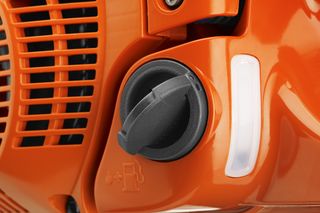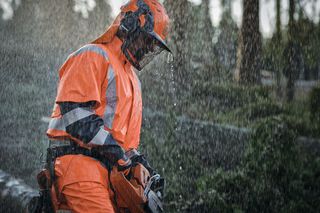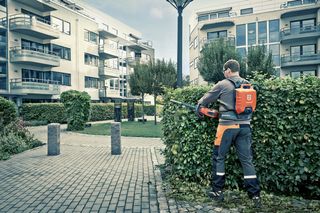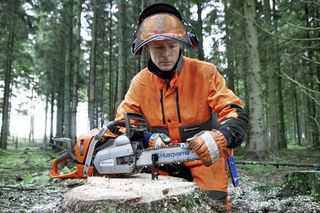
S138i Battery Scarifier - Let Your Lawn Breathe
Here’s everything you need to know about thatch and the ways to remove it for a healthier, happier lawn.
There's a misconception that thatch on a lawn is caused by blades of falling to the ground after mowing - resulting in a spongy and unhealthy look and feel. In fact, thatch forms for various reasons, from certain types of grass being more prone to the condition or improper fertilisation.
If newly emerging grass blades, stalks and roots emerge at roughly the same rate as old ones die and decompose, thatch won't occur. However, when new grass grows faster than the old grass can be broken down, a layer of thatch begins to form. Too much fertiliser is usually the leading cause.
A thin layer of thatch won't typically cause any issues and can actually help lawns retain moisture. But when it gets too thick, it can prevent water, nutrients, air and sunlight from reaching the root system, causing it to become lacklustre, fibrous and hard to manage.
Here's everything you need to know about thatch and the ways to remove it for a healthier, happier lawn.
What is Lawn Scarifying?
Scarifying is the process of using a tool or machine to cut and remove debris from the base of a lawn. The process typically boosts the overall health of lawns, encouraging greener growth and allowing nutrients to reach the roots more easily. In the past, it was a laborious process that involved manually raking the lawn to try and dislodge the thatch and remove it. Today, battery-powered machines cut, trim, loosen and remove it for a more even and professional finish.
Common Signs Of Lawn Thatch?
Thatch comes in a variety of densities and isn't always so easy to notice. A thin layer of thatch is expected on a lawn and can help retain moisture and nutrients without causing any issues. However, over time it can start to thicken, making it much easier to spot. Some of the main signs of lawn thatch include:
- Water runs off of the lawn instead of quickly draining away.
- It has a spongy or bouncy feel under your feet when walking on it.
- Grey or brown matted patches are visible or starting to show.
- The grass is growing much slower than usual.
- Your lawn edges and sides are visibly raised, dense and brown.
If you notice one or more of these common signs of lawn thatch, it may be time to remove it to help keep your lawn in the best possible condition for years to come.
How To Remove Lawn Thatch
The quickest and easiest way to scarify a lawn and remove thatch is with a scarifying machine. The S138i Battery-Powered Scarifier is a lightweight and compact 2-in-1 cordless machine powered by advanced Li-ion technology. Dual battery slots, 38 cm scarifying width and quick height adjustment make it the perfect tool for efficiently removing matted thatch from lawns.
The addition of an intuitive keypad, ergonomic, foldable handle and powerful output make dethatching simple. In addition, being battery-powered means there are zero direct emissions, fewer vibrations and quieter operation thanks to the brushless motor.
To remove thatch and scarify your lawn, choose a time when the grass is actively growing. Start by selecting your desired height via the central working height adjustment button on the chassis top. Next, push the power button to turn it on, and then slide the orange lock button to the left of the handle to activate the blades.
Starting at one corner of the garden, work your way up and down the length of the lawn, moving in one direction only. Once you have covered the entire lawn, remove any surface debris and check to see that all thatch has been scarified. Increase or decrease the scarifying speed by pushing the green button on the central keypad - a lower speed for particularly dense areas of thatch works best.
Lawns with many years of thatch growth may require a second treatment a few days later, especially if it is more than 1 inch thick. However, the S138i will quickly bring your lawn back to better health in no time at all. Once you have finished dethatching, generously water your lawn and fertilise as per your usual routine several weeks after completion.
How Often To Scarify A Lawn
The best time to dethatch a lawn is when the soil is reasonably moist and your grass is actively growing. How often you need to scarify will largely depend on how quickly lawn thatch accumulates.
- When thatch reaches a thickness of roughly ½ an inch or more.
- Once a year for lawns that produce less than ½ an inch annually.
- When water fails to be absorbed into the ground.
Remember, all lawns produce thatch, and a thin layer is a good indication of a healthy lawn. However, thick thatch is a clear sign of poor turf management and will actively work against your lawn's future health and growth. Annual scarification encourages improved growth while removing fibrous stalks and debris that can eventually suffocate a lawn.
The Benefits Of Scarifying Lawns
Lawn scarification comes with many benefits, reviving tired, dull and poorly-performing lawns. However, manual scarifying is labour-intensive and makes it hard to get a deep and even finish. Here are just a few of the main benefits of scarifying lawns and dethatching old-growth:
- Improved airflow to root systems.
- Easier absorption of water, eliminating runoff and pooling.
- Improved delivery of vital nutrients and fertiliser to the roots.
- Increased sunlight to emerging blades of grass for healthier growth.
- Greener, stronger blades of grass that give a lush look and feel.
- A reduction of brown and grey patches forming on your lawn.
Breathe New Life Into Thatched Lawns
Take back control and improve your lawn's health, texture, and look by performing annual scarification and dethatching with a battery-powered scarifier. Designed to provide maximum power and precision, it won't disturb the neighbours - just your thatch issues.
Ready to revive your lawn to its very best? The S138i will simplify your lawn care for the better, eliminating fibrous, dense and matted thatch so your lawn can breathe once more. Drop by your local Husqvarna dealer for a closer look at your lawn's new best friend.









